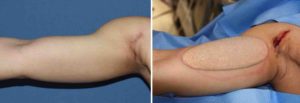Of the available eight sites for possible augmentation of the body by implants, the biceps muscle is number three, following pectoral and calf muscle augmentations. Like its cousin on the opposite side of the upper arm (triceps), the biceps muscle plays a major role in the movement of the arm. It has always had a dominant aesthetic role in the male for an enhanced muscular appearance.

While bicep implants may not be frequently performed, their placement is fairly straightforward. The most common pocket location is in the subfascial position on top of the muscle. An intermuscular location that more deeply places the implant can also be done but there is risk of nerve injury in that location to which the subfascial position has no such risk.
An axillary incision is always used as this provides the shortest distance to the biceps fascia with a fairly well hidden scar. The pocket is made with wide blunt instruments with emphasis on not perforating the fascia as one gets closer to the elbow with the subfascial dissection. The implant then easily inserted to the distal limit of the established pocket. The implant should glide smoothly up and down the pocket once in place.
Bicep implant insertion Dr Barry Eppley IndianapolisThe attached video shows a bicep implant insertion through an incision that is up out of the axillary fold. This was done because a prior scar was already in this location but normally this would be too high of an incision location.
Bicep implants are occasionally done by themselves but are just as frequently done in conjunction with pectoral and tricep implants for an overall enhanced upper body muscular appearance.
Dr. Barry Eppley
Indianapolis, Indiana



